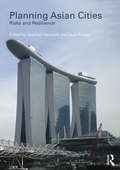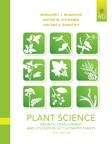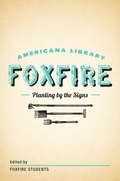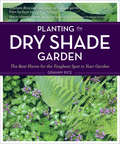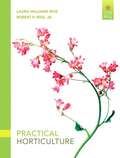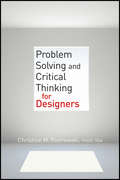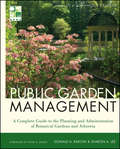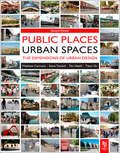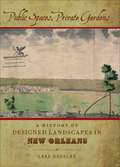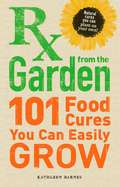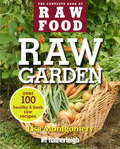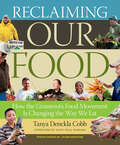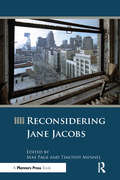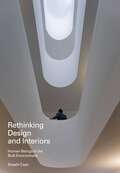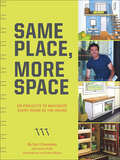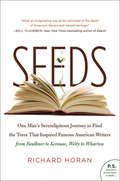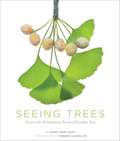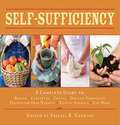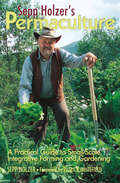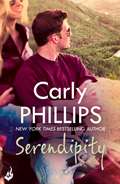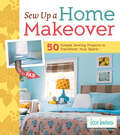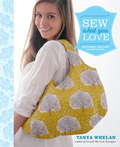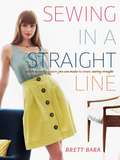- Table View
- List View
Planning Asian Cities: Risks and Resilience (Planning, History and Environment Series)
by Stephen Hamnett Dean ForbesIn Planning Asian Cities: Risks and Resilience, Stephen Hamnett and Dean Forbes have brought together some of the region’s most distinguished urbanists to explore the planning history and recent development of Pacific Asia’s major cities. They show how globalization, and the competition to achieve global city status, has had a profound effect on all these cities. Tokyo is an archetypal world city. Singapore, Hong Kong and Seoul have acquired world city characteristics. Taipei and Kuala Lumpur have been at the centre of expanding economies in which nationalism and global aspirations have been intertwined and expressed in the built environment. Beijing, Hong Kong and Shanghai have played key, sometimes competing, roles in China’s rapid economic growth. Bangkok’s amenity economy is currently threatened by political instability, while Jakarta and Manila are the core city-regions of less developed countries with sluggish economies and significant unrealized potential. But how resilient are these cities to the risks that they face? How can they manage continuing pressures for development and growth while reducing their vulnerability to a range of potential crises? How well prepared are they for climate change? How can they build social capital, so important to a city’s recovery from shocks and disasters? What forms of governance and planning are appropriate for the vast mega-regions that are emerging? And, given the tradition of top-down, centralized, state-directed planning which drove the economic growth of many of these cities in the last century, what prospects are there of them becoming more inclusive and sensitive to the diverse needs of their populations and to the importance of culture, heritage and local places in creating liveable cities?
Plant Science: Growth, Development, and Utilization of Cultivated Plants
by Margaret E. Mcmahon Anton M. Kofranek Vincent E. RubatzkyPlant Science: Growth, Development, and Utilization of Cultivated Plants, Fifth Edition, is an outstanding resource for anyone with an interest in how plants are grown and utilized for maintaining and adding enjoyment to human life. The text starts with the fundamentals of botany, plant physiology, and environmental factors affecting plant growth, while later sections integrate those topics into strategies of producing plants for human use as food, fiber, and recreation. The concept of sustainability and sustainable methods of growing plants runs throughout the text. Whether you are familiar or unfamiliar with plant science, this book will give you a firm understanding of concepts and terminology related to the growing of plants.
Planting By the Signs: The Foxfire Americana Library (10) (The Foxfire Americana Library)
by Inc. Foxfire FundAn Appalachian farmer's almanac, "Planting by the Signs" is a valuable resource for the gardener looking for time-honored tips for clearing land and growing vegetables from the people who originally pioneered the art through hard work (and a little bit of luck). In the spirit of the Foxfire Americana Library, this entry also contains a collection of gardening-related folklore, including signs to tell that winter is coming and a guide to planting successfully according to the stars.
Planting the Dry Shade Garden: The Best Plants for the Toughest Spot in Your Garden
by Graham RiceIn this book you'll learn how to prune selectively to admit more light and how to amend soil to increase its moisture retention. You'll also learn about more than 130 plants that accept reduced light and moisture levels-long-blooming woodland gems like epimediums and hellebores, and even lush foliage plants like evergreen ferns and hardy gingers, shrubs, climbers, perennials, ground covers, bulbs, annuals, and perennials- there is an entire palette to help you transform challenging spaces into rich, rewarding gardens.
Practical Horticulture
by Robert Rice Laura RicePractical Horticulture, Seventh Edition, is a classic, scientifically oriented book for basic horticulture. It presents readers with the fundamentals of horticultural science and its applications in both the commercial and home sectors. Easy-to-read, the books’s ample illustrations, chapter objectives, and chapter-ending review questions, help readers learn the concepts. Some exciting new features to this edition include: Updated with timely coverage of hot environmental topics. The latest information on horticultural science for indoor and outdoor plants. A new chapter on careers in horticulture has been added. This is a great resource for anyone interested in horticulture!
Problem Solving and Critical Thinking for Designers
by Christine M. PiotrowskiThe essential guide to decision making and problem solving for the interior designer The interior design profession requires effective problem solving and critical thinking, as they impact all phases of the design project and most work activities of the interior designer. Whether you are a student or professional designer, much of what you do involves these skills. Although most of us do not even think about what we do in terms of these activities, they are a constant part of design. They are also skills that must be performed successfully outside a professional career. Improving these skills makes you a more sought-after employee and designer, effective business owner, and fulfilled individual. Problem Solving and Critical Thinking for Designers will put the reader on the correct path to a solutions-oriented practice. Using her trademark accessible and conversational approach, Christine Piotrowski guides readers through the process of how the working designer solves problems and makes decisions. Some of the topics she discusses are: Design process Communication Asking questions Problem definition and analysis Decision-making process Negotiation Working with others Ethical decision making This book also features real-life scenarios and design problems that guide the reader toward making correct decisions in real-life situations.
Public Garden Management
by Donald A. Rakow Sharon A. LeeThe complete-and-ready reference for establishing, managing, and running a successful and sustainable, profitable public garden As unique museums with living collections of plants, public gardens offer visitors aesthetically beautiful landscapes combined with educational programming and scientific research that promote the value and understanding of plants. In the twenty-first century, public gardens are in the forefront of organizations and institutions committed to promoting the conservation of plants and their habitats, developing sustainable practices that support the environment, and providing green spaces where our increasingly stressed and urbanized citizens can reconnect with the natural world. It is critically important that such institutions have trained, knowledgeable staff members. Because of its comprehensive examination of public gardens, Public Garden Management is the ideal guide for staff members at public gardens, anyone considering a career in public gardens, groups starting a botanical garden or arboretum, and students discovering how these complex institutions work. Public Garden Management is an all-in-one professional reference and textbook that clearly shows how to develop, establish, manage, and maintain a sustainable-both economically and environmentally-public garden. Offering practical coverage of relevant topics, along with useful tools for reinforcing study, this insightful and forward-thinking guide is: Copublished by the American Public Gardens Association Written by a panel of leading experts in the field Filled with dozens of case studies that are real-world illustrations of the principles explored in the text Illustrated throughout with line drawings, figures, and photographs that assist in conveying critical information Students and professionals will benefit greatly from the management principles outlined in this book, helping them establish and maintain new and existing public gardens that engage, inspire, and connect with their communities.
Public Places - Urban Spaces
by Steve Tiesdell Tim Heath Taner OcPublic Places Urban Spaces, 2e, is a thorough introduction to the principles of urban design theory and practice. Authored by experts in the fields of urban design and planning, it is designed specifically for the 2,500 postgraduate students on Urban Design courses in the UK, and 1,500 students on undergraduate courses in the same subject.The 2e of this tried and trusted textbook has been updated with relevant case studies to show students how principles have been put into practice. The book is now in full color and in a larger format, so students and lecturers get a much stronger visual package and easy-to-use layout, enabling them to more easily practically apply principles of urban design to their projects.Sustainability is the driving factor in urban regeneration and new urban development, and the new edition is focused on best sustainable design and practice. Public Places Urban Spaces is a must-have purchase for those on urban design courses and for professionals who want to update and refresh their knowledge.
Public Spaces, Private Gardens: A History of Designed Landscapes in New Orleans
by Lake DouglasLandscape architect Lake Douglas employs written accounts, archival data, historic photographs, lithographs, maps, and city planning documents -- many of which have never before been published -- to explore public and private outdoor spaces in New Orleans and those who shaped them. The result offers the first in-depth examination of the city's landscape history.Douglas presents this "beautiful and imposing" city as a work of art crafted by numerous influences. His survey from the colonial period to the twentieth century finds that geography, climate, and, above all, the multicultural character of its residents have made New Orleans unique in American landscape design history. French and Spanish settlers, Africans and Native Americans, as well as immigrants from Germany, Ireland, Italy, and other parts of the world all participated in creating this community's unique public and private landscapes. Places such as Congo Square, Audubon Park, the river levees, and "neutral grounds" -- local residents' own term for medians -- together with ordinary residential gardens are all testaments to the city's international imprint. Douglas identifies five types of public and private designed landscapes in New Orleans: squares, linear open spaces, urban parks, commercial pleasure gardens, and domestic gardens. Discussing their design, function, and content, he shows how specific examples of each contribute to the city's unique character and also fit within the larger context of American landscape design history. Each type has its own complexion and reflects the influence of those who occupied it. Though New Orleanians lived in strata according to language, cultural identity, economics, and race, they found common ground, literally, in their community's landscapes.Douglas's sweeping study, illustrated with over 90 color and black-and-white images, includes an exploration of archival horticultural books, almanacs, and periodicals; information about laborers who actually built landscapes; details of horticultural commerce, services, and marketing materials; and an exhaustive inventory of plants grown in New Orleans for agricultural, medicinal, and ornamental uses.Public Spaces, Private Gardens provides an informative look at two hundred years of the designed landscapes and horticulture of New Orleans and a fresh perspective on one of America's most interesting and historic cities.
RX from the Garden: 101 Food Cures You Can Easily Grow
by Kathleen BarnesYour backyard becomes an all-natural pharmacy!Colds. Headaches. Upset stomach, Allergy symptoms. Depression. Circulation problems.This timely book goes beyond using herbs as medicine; it also focuses on beneficial foods for more than 100 common ailments and shows you how to grow them.In that way, RX from the Garden lets you circumvent expensive meds with questionable side effects by explaining what foods to eat to help you feel better. In addition to aligning health problems with natural cures, this valuable resource provides step-by-step instruction on how to easily cultivate the corresponding vegetables and herbs in your lawn, garden, or flowerbed.According to Hippocrates, "Our food should be our medicine. Our medicine should be our food." Now you can reap health benefits for your very own backyard bounty.
Raw Garden: Over 100 Healthy and Fresh Raw Recipes
by Lisa MontgomeryGet the most out of your garden with these delicious raw food recipes!If you love growing your own fruits and vegetables, but are unsure how to start using your harvest, now is your chance to learn. Whether you're new to gardening or have been doing it for years, Raw Garden is the perfect resource to help you create dishes based on ingredients found in your garden by sharing simple, delicious raw food recipes for you to try. From salads and snacks, to main dishes and desserts, Raw Garden has some of the best raw food recipes you can find.Some of the over 100 delicious and creative recipes featured in Raw Garden include Curry Carrot Salad, Cranberry Walnut Coleslaw, Southwestern Stuffed Avocadoes, Goji Coconut Cream Sauce, Pine Nut Parmesan, Turkey Nut Burgers, Sea Spaghetti Alfredo, Banana Ice Cream, Pineapple Salsa, and much more!Packed with lots of practical and helpful information, Raw Garden also includes:* Tips on planning your garden* Benefits of growing and eating raw food* How to garden in small living spaces* A guide to the art of bee- and chicken-keepingWith unique and exciting raw recipes, Raw Garden is sure to bring your gardening, and your meals, to new heights!
Reclaiming Our Food: How the Grassroots Food Movement Is Changing the Way We Eat
by Tanya Denckla CobbReclaiming Our Food tells the stories of people across the United States who are finding new ways to grow, process, and distribute food for their own communities. Discover how abandoned urban lots have been turned into productive organic farms, how a family-run sustainable fish farm can stay local and be profitable, and how engaged communities are bringing fresh produce into school cafeterias. Through photographic essays and interviews with innovative food leaders, you’ll be inspired to get involved and help cultivate your own local food economy.
Reconsidering Jane Jacobs
by Max Page Timothy MennelThis volume begins with the premise that the deepest respect is shown through honest critique. One of the greatest problems in understanding the influence of the author on cities and planning is that she has for much of the past five decades been "Saint Jane, the housewife" who upended urban renewal and gave us back our cities. Over time, she has become a saintly stick figure, a font of simple wisdom for urban health that allows many to recite her ideas and few to understand their complexity. The author has been the victim of her own success. This book gives this important thinker the respect she deserves, reminding planning professionals of the full range and complexity of her ideas and offering thoughtful critiques on the unintended consequences of her ideas on cities and planning today. It also looks at the international relevance – or lack thereof – of her work, with essays on urbanism in Abu Dhabi, Argentina, China, the Netherlands, and elsewhere.
Residential Interior Design
by Maureen Mitton Courtney NystuenThe completely revised room-by-room guide to home interior designResidential Interior Design, Second Edition teaches the fundamental skills that are needed to plan interior spaces for all types of homes, regardless of decorative styles, from remodeling to new construction. Taking a step-by-step approach, this valuable primer reviews all aspects of interior architecture as it relates to human factors and daily use.Authors Maureen Mitton and Courtney Nystuen explore the minimal amount of space that is necessary for rooms to function usefully, from the kitchen to the bathroom, the bedroom to the hallway, and every room in between. Packed with hundreds of drawings and photographs, this valuable tool is brimming with useful information regarding codes, mechanical and electrical systems, keys to creating wheelchair accessible spaces, and a variety of additional factors that impact each type of room and its corresponding space. Now featuring a companion website with instructor resources, this new edition is:Revised and updated with new building codes information and expanded information on sustainability, building construction, doors, windows, home offices, and outdoor spacesIllustrated throughout with line drawings and photographs to clearly explain the concepts coveredThe perfect study aid for the NCIDQ examWith a focus on quality of design over quantity of space, Residential Interior Design, Second Edition is the first stop to designing equally efficient and attractive rooms.
Rethinking Design and Interiors: Human Beings In The Built Environment
by Shashi CaanThe world and the people living in it are increasingly and rapidly being affected by environmental and technological changes. It is imperative that the design profession addresses these developments with a new way of thinking. This book points the way for the design of interiors in this newly complex world and will be indispensable for students, practitioners and theoreticians.The book is divided into four chapters that explore aspects of the human experience of the interior, from man’s earliest search for shelter to an outline of past and current thinking on design, psychology and well-being. An epilogue looks at such future concerns as population growth and sustainability and suggests how the design profession can confront these challenges.Rethinking Design and Interiors is a fascinating exploration of how art and science can come together for the benefit of those who inhabit the built environment.
Rethinking Design and Interiors: Human Beings in the Built Environment
by Shashi CaanThe world and the people living in it are increasingly and rapidly being affected by environmental and technological changes. It is imperative that the design profession addresses these developments with a new way of thinking. This book points the way for the design of interiors in this newly complex world and will be indispensable for students, practitioners and theoreticians.The book is divided into four chapters that explore aspects of the human experience of the interior, from man’s earliest search for shelter to an outline of past and current thinking on design, psychology and well-being. An epilogue looks at such future concerns as population growth and sustainability and suggests how the design profession can confront these challenges.Rethinking Design and Interiors is a fascinating exploration of how art and science can come together for the benefit of those who inhabit the built environment.
Same Place, More Space: 50 Projects to Maximize Every Room in the House
by Karen Kelly Karl ChampleyFind extra room in your home and “inspiration for the storage-impaired” with these projects from the master carpenter and DIY Network host. Karl Champley offers fifty home improvement projects to maximize space in any dwelling, no matter how big or small. Keeping an eye on style and economy, Champley outlines tools, materials, and techniques for searching out and using hidden-away space to achieve incredible results. Learn how to carve out shelving niches between studs in the wall, tuck more into kitchen cupboards, build hidey-holes beneath floorboards, and much more. The projects range from easy organization solutions to weekend construction projects and more ambitious undertakings. With easy-to-follow instructions for making more out of less, detailed illustrations, and no-nonsense advice on clutter control, Same Place, More Space makes it simple to create a more functional, expansive, and beautiful home without major remodeling.
Seeds
by Richard HoranFrom the wooded road made of golden hemlock running past L. Frank Baum's childhood home to the lonely stump of Scout's oak in Harper Lee's Alabama, author Richard Horan gathers tree seeds-and stories-from the homes of America's most treasured authors. At once a heartfelt paean to literature and a wise, funny, and uplifting account of one man's reconnection with nature, Seeds celebrates Horan's triumphs and calamities on his quest to link trees with great writers-a delightfully original meditation on the nature of inspiration and a one-of-a-kind adventure into literature.
Seeing Trees: Discover the Extraordinary Secrets of Everyday Trees (Seeing Series)
by Nancy Ross Hugo Robert LlewellynHave you ever looked at a tree? That may sound like a silly question, but there is so much more to notice about a tree than first meets the eye. Seeing Trees celebrates seldom seen but easily observable tree traits and invites you to watch trees with the same care and sensitivity that birdwatchers watch birds. Many people, for example, are surprised to learn that oaks and maples have flowers, much less flowers that are astonishingly beautiful when viewed up close. Focusing on widely grown trees, this captivating book describes the rewards of careful and regular tree viewing, outlines strategies for improving your observations, and describes some of the most visually interesting tree structures, including leaves, flowers, buds, leaf scars, twigs, and bark. In-depth profiles of ten familiar species—including such beloved trees as white oak, southern magnolia, white pine, and tulip poplar—show you how to recognize and understand many of their most compelling (but usually overlooked) physical features.
Self-Sufficiency: A Complete Guide to Baking, Carpentry, Crafts, Organic Gardening, Preserving Your Harvest, Raising Animals, and More! (Self-Sufficiency Series)
by Abigail R. GehringNow, more than ever, people across the country are turning toward simpler, greener, and quieter ways of living--whether they're urbanites or country folk. Following in the footsteps of Back to Basics and Homesteading, this large, fully-illustrated book provides the entire family with the information they need to make the shift toward self-sufficient living. Self-Sufficiency provides tips, advice, and detailed instructions on how to improve everyday life from an environmentally and organic perspective while keeping the focus on the family. Readers will learn how to plant a family garden and harvest the produce; can fruits and vegetables; bake bread and cookies; design interactive and engaging "green" projects; harness natural wind and solar energy to cook food and warm their homes; boil sap to make maple syrup; and build treehouses, furniture, and more. Also included are natural crafts readers can do with their kids, such as scrapbooking, making potato prints, dipping candles, and constructing seasonal decorations. Whether the goal is to live entirely off the grid or just to shrink their carbon footprints, families will find this book a thorough resource and a great inspiration.
Sepp Holzer's Permaculture: A Practical Guide to Small-Scale, Integrative Farming and Gardening
by Sepp HolzerSepp Holzer farms steep mountainsides in Austria 1,500 meters above sea level. His farm is an intricate network of terraces, raised beds, ponds, waterways and tracks, well covered with productive fruit trees and other vegetation, with the farmhouse neatly nestling amongst them. This is in dramatic contrast to his neighbors&’ spruce monocultures.In this book, Holzer shares the skill and knowledge acquired over his lifetime. He covers every aspect of his farming methods, not just how to create a holistic system on the farm itself, but how to make a living from it. Holzer writes about everything from the overall concepts, down to the practical details. In Sepp Holzer&’s Permaculture readers will learn:How he sets up a permaculture systemThe fruit varieties he has found best for permaculture growingHow to construct terraces, ponds, and waterwaysHow to build shelters for animals and how to work with them on the landHow to cultivate edible mushrooms in the garden and on the farmand much more!Holzer offers a wealth of information for the gardener, smallholder or alternative farmer yet the book&’s greatest value is the attitudes it teaches. He reveals the thinking processes based on principles found in nature that create his productive systems. These can be applied anywhere.
Serendipity: Serendipity Book 1 (Serendipity)
by Carly PhillipsThe New York Times bestselling author of the Dare to Love series welcomes you to Serendipity, where love, fate and fortune intertwine... Fans of Bella Andre, Rachel Gibson, Julie James and Jill Shalvis, will fall head over heels with Carly Phillips' special town and her unforgettable characters.When her life falls apart, Faith Harrington returns to Serendipity - but not everyone is ready to forget the scandal her family brought to the town. Ethan Barron, no stranger to scandal himself, never imagined he'd again come face-to-face with Faith - the princess he once kissed senseless. When he hires her to redecorate her childhood home, Faith is sure that getting involved with the town's notorious bad boy will lead only to trouble. But her heart has other ideas. And so do the townspeople of Serendipity...Return to Serendipity for more sexy romance with the other books in the series, Destiny, Karma, Fated, Perfect Fit, Perfect Fling and Perfect Together.
Sew Up a Home Makeover: 50 Simple Sewing Projects to Transform Your Space
by Lexie BarnesGive your home a fresh new look. Lexie Barnes shows you how to quickly and inexpensively personalize your living space with 50 fun, pattern-free sewing projects that are highly adaptable and visually inspiring. Dramatic before-and-after photographs demonstrate how easy it is to brighten your living room with a custom-designed slipcover or give new life to a bedroom with a colorful headboard cover, lampshade, and matching window treatments. Get sewing and transform your home into the stylish abode you’ve always craved.
Sew What You Love
by Tanya Whelan30 surprisingly simple--yet delightfully charming--sewing projects Grand Revival designer Tanya Whelan's vintage modern aesthetic has made her fabrics and sewing patterns some of the most admired by sewers and quilters everywhere. In her first book, she presents a stylish collection of 30 easy-to-make sewing projects that are achievable by sewers of every skill level. Ranging from a pretty pleated clutch to a flirty French-inspired day dress and super-cute soft baby toys to a mistake-proof design-as-you-go quilt, each project comes with step-by-step instructions and illustrations, inspiring photographs, and helpful tips. These projects and patterns for children, adults, and the home are guaranteed to work well and produce a beautiful end result. Included are 3 pattern sheets enclosed in a handy pocket, providing everything you need to start stitching something you are sure to love. With Tanya's passion for sewing featured on every page, you'll soon discover just how gratifying sewing can be. From the Trade Paperback edition.
Sewing in a Straight Line: Quick and Crafty Projects You Can Make by Simply Sewing Straight
by Brett BaraIn just one weekend and using one skill, sewing straight, an entire world of sophisticated, but easily doable projects is open to you. Just about anyone can sew a straight line. And with that simple skill and some basic guidance, crafty expert Brett Bara demonstrates how you can make custom home decor, stylish fashions and one-of-a-kind gifts. "Sewing in a Straight Line" is a step-by-step guide to creating 28 deceptively simple projects that look like they came from a chic boutique, far more impressive than you would expect for such little effort! These easy-to-make items offer quick gratification that even the busiest among us will appreciate. From a flirty two-hour miniskirt to the cutest plush toys, many of the projects take only a spare afternoon. With step-by-step illustrations, clear instructions and loads of helpful hints and customisation ideas, "Sewing in a Straight Line" will quickly make a sewing enthusiast out of anyone.
